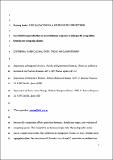Por favor, use este identificador para citar o enlazar a este item:
http://hdl.handle.net/10261/230833COMPARTIR / EXPORTAR:
 SHARE SHARE
 CORE
BASE CORE
BASE
|
|
| Visualizar otros formatos: MARC | Dublin Core | RDF | ORE | MODS | METS | DIDL | DATACITE | |

| Título: | Local habitat specialization as an evolutionary response to interspecific competition between two sympatric shrews |
Autor: | Biedma, Luis; Calzada, Javier CSIC ORCID; Godoy, José A. CSIC ORCID CVN ; Román, Jacinto CSIC ORCID | Palabras clave: | Coexistence Crocidura Ecologically similar species Evolutionary response Habitat specialization Habitat use Interspecific competition Niche segregation |
Fecha de publicación: | 2020 | Editor: | American Society of Mammalogists | Citación: | Journal of Mammalogy 101: 80- 91 (2020) | Resumen: | Interspecific competition affects population dynamics, distributional ranges, and evolution of competing species. The competitive exclusion principle states that ecologically similar species cannot coexist unless they exhibit niche segregation. Herein, we assess whether niche segregation allows the coexistence of Crocidura russula and C. suaveolens in southwestern Iberia and whether segregation is the result of current (ecological effect) or past (evolutionary effect) competition. We performed an annual live-trapping cycle in the two main habitats of the Odiel Marshes Natural Reserve (OMNR), the tidal marsh and the Mediterranean forest, both in syntopic (i.e., where both species co-occur) and allotopic (where only one of the two species occurs) sites within this Reserve. We modeled the presence-absence of each species in both habitats and sites by generalized linear mixed models. The coexistence of both species was favored by spatial and temporal niche segregation. Crocidura suaveolens was restricted to tidal marsh and did not occupy Mediterranean forest, even when C. russula was absent. We interpret this to be the result of competition in the past triggering an evolutionary response in C. suaveolens towards its specialization in tidal marsh. Moreover, the specialist C. suaveolens currently is outcompeting C. russula in tidal marshes, reversing the dominance pattern observed elsewhere. The degree of co-occurrence between both species in syntopic sites was low, as they showed inverse dynamics of seasonal abundances. Interspecific competition leading to habitat specialization favors the coexistence of these ecologically similar species. | Versión del editor: | http://dx.doi.org/10.1093/jmammal/gyz203 | URI: | http://hdl.handle.net/10261/230833 | DOI: | 10.1093/jmammal/gyz203 | Identificadores: | doi: 10.1093/jmammal/gyz203 issn: 1545-1542 |
| Aparece en las colecciones: | (EBD) Artículos |
Ficheros en este ítem:
| Fichero | Descripción | Tamaño | Formato | |
|---|---|---|---|---|
| Revised_Main document_JMAMM-2019-102-R1-two-sympatric-shrews-EIC.pdf | 466,11 kB | Adobe PDF |  Visualizar/Abrir |
CORE Recommender
Page view(s)
46
checked on 19-abr-2024
Download(s)
103
checked on 19-abr-2024
Google ScholarTM
Check
Altmetric
Altmetric
NOTA: Los ítems de Digital.CSIC están protegidos por copyright, con todos los derechos reservados, a menos que se indique lo contrario.
